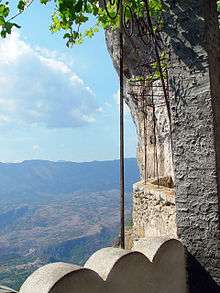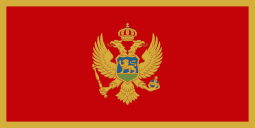Bjelopavlići
Coordinates: 42°39′N 19°01′E / 42.650°N 19.017°E Bjelopavlići (pronounced [bjɛlɔ̌paːv̞lit͡ɕi], Serbian Cyrillic: Бјелопавлићи; also known as the Zeta River valley) is a strip of fertile lowland in Montenegro. It stretches along the Zeta river, being wider in river's lower end, down to the confluence with Morača river near Podgorica. The Bjelopavlići clan originates from this valley. Bjelopavlići was a tribal region part of the Hills (Brda), one of "the seven hills" (or "tribes") alongside Vasojevići, Piperi, Kuči, Bratonožići, Moračani and Rovčani. The region is situated around Danilovgrad.

Zeta river valley has historically been densely populated, as fertile lowlands are rare in mountainous Montenegro.
Confusingly, the other significant plain in Montenegro, Zeta plain has been named after Zeta river, although Zeta river itself does not flow through it.
The Bjelopavlići plain provided a corridor for road and rail connection between two biggest Montenegrin cities, Podgorica and Nikšić. The largest settlement in the plain is the town of Danilovgrad which got name by Prince (Knjaz) Danilo Petrović.
Early history
Bjelopavlići are first mentioned as Serbs in a Ragusan document dating to 1411, when they, together with the Malonšići, Ozrinići and Maznići, had looted a ship of the Republic of Ragusa (from Dubrovnik). The eponymous founder, Bijeli Pavle ("White Paul"), is said to have fled Metohija from the Ottomans, and settling in Luška župa (Latin: Lusca, later known as Zeta).
In 1496, the Ottomans conquered the greater part of Zeta and the surrounding area called "Hills" (Brda), which included the Vasojevići, Bjelopavlići, Piperi, Kuči, Bratonožići, Moračani and Rovčani. The tribe came under the Sanjak of Scutari.
16th century
The burning of Saint Sava's remains after the Banat Uprising provoked the Serbs in other regions to revolt against the Ottomans.[1] In 1596, an uprising broke out in Bjelopavlići, then spread to Drobnjaci, Nikšić, Piva and Gacko (see Serb Uprising of 1596–97). It was suppressed due to lack of foreign support.[2]
17th century
In 1612 the Sultan sent the son of Mehmet Pasha to Podgorica to tackle the uprisings by the people. The Pasha remained in Podgorica for three months and then decided to ravage Bjelopavlići, taking 80 women and children as slaves, setting the village on fire and stealing animals. The males were hiding in other villages and upon the department of the Ottoman soldiers, the tribesmen attacked and killed 300 sipahis with their horses and baggage stolen.[3] In 1613, the Ottomans launched a campaign against the rebel tribes of Montenegro. They reached an agreement with the rebels for 1,000 ducats and 12 slaves.[3] Venetian Mariano Bolizza (fl. May 1614) recorded that the region was under the command of the Ottoman army in Podgorica. There was 800 armed men of Bjelopavlići (Italian: Biellopaulichi), commanded by Neneca Latinović and Bratič Tomašević. Later that year, the Bjelopavlići, Kuči, Piperi, and Kelmend sent a letter to the kings of Spain and France claiming they were independent from Ottoman rule and did not pay tribute to the empire.[4]
18th century
In 1774, in the same month of the death of Šćepan Mali,[5] Mehmed Pasha Bushati attacked the Kuči and Bjelopavlići,[6] but was decisively defeated and returned to Scutari.[5]
19th century
Prince-Bishop Petar I (r. 1782-1830) waged a successful campaign against the bey of Bosnia in 1819; the repulse of an Ottoman invasion from Albania during the Russo-Turkish War (1828–29) led to the recognition of Montenegrin sovereignty over Piperi.[7] Petar I had managed to unite the Piperi and Bjelopavlići with Montenegro,[7] and when Bjelopavlići and the rest of the Hills (Seven hills) were joined into Peter's state, a polity officially called "Black Mountain (Montenegro) and the Hills".[8] A civil war broke out in 1847, in which the Piperi, Kuči, Bjelopavlići and Crmnica sought to confront the growing centralized power of new prince of Montenegro; the secessionists were subdued and their ringleaders shot.[9] Amid the Crimean War, there was a political problem in Montenegro; Danilo I's uncle, George, urged for yet another war against the Ottomans, but the Austrians advised Danilo not to take arms.[10] A conspiracy was formed against Danilo, led by his uncles George and Pero, the situation came to its height when the Ottomans stationed troops along the Herzegovinian frontier, provoking the mountaineers.[10] Some urged an attack on Bar, others raided into Herzegovina, and the discontent of Danilo's subjects grew so much that the Piperi, Kuči and Bjelopavlići, the recent and still unamalgamated acquisitions, proclaimed themselves an independent state in July, 1854.[10] In Danilo I's Code, dated to 1855, he explicitly states that he is the "knjaz (duke, prince) and gospodar (lord) of the Free Black Mountain (Montenegro) and the Hills".[11] Danilo was forced to take measurement against the rebels in Brda, some rebels crossed into Ottoman territory and some submitted and were to pay for the civil war they had caused.[10] Knjaz Danilo was assassinated in August, 1860 as he was boarding a ship at the port of Kotor. The assassin, Chief Todor Kadić of the Bjelopavlići, was said to be assisted by Austrian authorities in carrying out the assassination. Some speculate that there was a personal feud between the two, the fact that Danilo had an affair with Todor's wife and the ongoing mistreatment of the Bjelopavlići tribe by Danilo's guards and his forces.[12]
20th century
During Nikola I, the Bjelopavlici had bad relations with the rule as a member of the tribe, Andrija Radović, was sentenced to 15 years in a bombing trial and the trials in 1908-1909 further damaged relations.[13]
Anthropology
All families have the slava of Parascheva of the Balkans (sv. Petka).
- Brotherhoods
- Vražegrmci and Martinići, descend from Buba Šćepanović
- Pavkovići, descend from Pavko Mitrović
- Brajović, descend from Brajo Pavković
- Petrušinovići, descend from Petar Mitrović
- Matijaševići and Tomaševići, descend from Nikola Mitrović
- Kalezići, descend from Kaleta Mitrović
- Lužani, natives
People
- Locals
- Andrija Radović, Montenegrin politician
- Novica Radović, Montenegrin politician
- Dragan Radović, retired Montenegrin footballer
- Staniša Marković Mlatišuma, famous Montenegrin Serb hajduk
- Milutin Savić, Serbian revolutionary and member of National council
- Ilija Garašanin, Serbian politician, Milutin Savić's son
- Vasos Mavrovouniotis, hero of the Greek Revolution against Ottoman Empire
- Radivoje Brajović, President of the Presidency of the Socialist Republic of Montenegro from 1986-1988
- Veljko Milatović, Montenegrin communist politician and president
- Veselin Đuranović, Montenegrin communist politician
- Jovica Stanišić, former head of the State Security Service within the Serbian Ministry of the Interior now on trial at the ICTY for involvement in the wars in Croatia and in Bosnia and Herzegovina.
- Bajo Stanišić, Chetnik commander during World War II
- Ljubo Novaković, Yugoslav officer and Chetnik commander during World War II
- Dragan Jočić, Serbian politician and former Minister of Internal Affairs
- Dragiša Pešić, Montenegrin politician
- Dragan Đurović, Montenegrin politician
- Borislav Jovanović, Montenegrin writer
- Borislav Pelević, Serbian politician
- Vojislav Brajović, famous Serbian actor
- Slobodan Marunović, Montenegrin actor
- Zoran Kalezić, prominent Serbian-Montenegrin singer
- Nikola Šaranović, Montenegrin sport shooter
- By ancestry
- Zoran Filipović, Montenegrin former football player and coach, by ancestry
- Vojin Ćetković, Serbian actor, by ancestry
- Tanja Bošković, Serbian actress, by ancestry
References
- ↑ Bataković 1996, p. 33.
- ↑ Ćorović, Vladimir (2001) [1997]. "Преокрет у држању Срба". Историја српског народа (in Serbian). Belgrade: Јанус.
- 1 2 Mariano Bolizza
- ↑ Kulišić, Špiro (1980). O etnogenezi Crnogoraca (in Montenegrin). Pobjeda. p. 41. Retrieved 19 November 2011.
- 1 2 Zapisi. Cetinjsko istorijsko društvo. 1939.
Истога мјесеца кад је Шћепан погинуо удари на Куче везир скадарски Мехмед - паша Бушатлија , но с великом погибијом би сузбијен и врати се у Скадар .
- ↑ Летопис Матице српске. У Српској народној задружној штампарији. 1898.
Године 1774. везир скадарски Мехмед паша Бушатлија ударио је на Куче и Бјелопавлиће, који позваше у помоћ Црногорце те произиђе због овога међу Црном Гором и Арбанијом велики бој и Арбанаси су се повукли ...
- 1 2 Miller, p. 142
- ↑ Etnografski institut (Srpska akademija nauka i umetnosti) (1952). Posebna izdanja, Volumes 4-8. Naučno delo. p. 101.
Када, за владе Петра I, црногорсксу држави приступе Б^елопавлиЬи, па после и остала Брда, онда je, званично, „Црна Гора и Брда"
- ↑ Miller, p. 144
- 1 2 3 4 Miller, p. 218
- ↑ Stvaranje, 7–12. Obod. 1984. p. 1422.
Црне Горе и Брда историјска стварност коЈа се не може занема- рити, што се види из назива Законика Данила I, донесеног 1855. године који гласи: „ЗАКОНИК ДАНИЛА I КЊАЗА И ГОСПОДАРА СЛОБОДНЕ ЦРНЕ ГОРЕ И БРДА".
- ↑ Srdja Pavlovic (2008). Balkan Anschluss: The Annexation of Montenegro and the Creation of the Common South Slavic State. Purdue University Press. pp. 39–. ISBN 978-1-55753-465-1.
- ↑ Ivo Banac (1988). The National Question in Yugoslavia: Origins, History, Politics. Cornell University Press. ISBN 0-8014-9493-1.
Sources
- Bataković, Dušan T. (1996). The Serbs of Bosnia & Herzegovina: History and Politics. Dialogue Association.
- William Miller (12 October 2012). The Ottoman Empire and Its Successors 1801-1927. Routledge. ISBN 978-1-136-26046-9.
